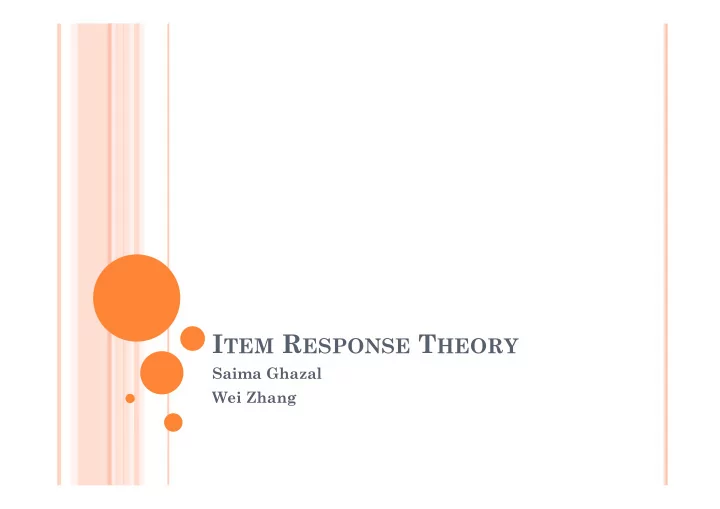

I TEM R ESPONSE T HEORY Saima Ghazal Wei Zhang
I NTRODUCTION OF I TEM R ESPONSE T HEORY IRT derives the probability of each response as a function of person parameter and some item parameters. The person parameter is called latent trait or ability. The item parameters include the difficulty of an item, discrimination parameter and guessing parameter. The ultimate aim of IRT is to test people. Source: P, Ivailo. 2004. A visual guide to item response theory. http://www.metheval.uni-jena.de/irt/VisualIRT.pdf
T HE T HREE M ODELS The item response function gives the probability that a person with a given ability level will answer correctly. The Rasch model ⌃ The 2 PL model ⌃ ⌃ The 3 PL model ⌃ ⌃ ⌃ * Θ , individual ability; b, difficulty parameter; a, discrimination parameter; c, guessing parameter. The index i refers to items, the index j refers to persons. Source: P, Ivailo. 2004. A visual guide to item response theory. http://www.metheval.uni-jena.de/irt/VisualIRT.pdf
T HE R ASCH M ODEL The simplest IRT model has only one item difficulty parameter. The function gives us the probability of a correct response as a function of the individual ability θ given the single item difficulty parameter b . Suppose each line stands for one item in a test. � Five items whose difficulties are (-2.2, -1.5, 0, 1.0, 2.0). The five curves run parallel to each other and never cross. We assume that they have the same discrimination parameter. Source: P, Ivailo. 2004. A visual guide to item response theory. http://www.metheval.uni-jena.de/irt/VisualIRT.pdf
T WO P ARAMETER M ODEL Two of the items have the same difficulty of (-1) and the difficulty yields a same response probability of 0.5. The slope indicates the discrimination parameter. The blue curve is much steeper than the black one, which means the blue item is better at discriminating the people within level [-2,1] than the black item. The green curve has the same slope as the black one, but shifted to the right, hence the item with green curve has the same discrimination parameter as the item with black curve but a higher difficulty. Source: P, Ivailo. 2004. A visual guide to item response theory. http://www.metheval.uni-jena.de/irt/VisualIRT.pdf
T HREE P ARAMETER M ODEL Difference? The difference is the addition of a guessing parameter. The red curve is the original 2 PL model with b = 1.75, a = 2.42. The blue curve is a 3 PL model with b = 1.75, a = 2.42, and c = 0.2. Source: P, Ivailo. 2004. A visual guide to item response theory. http://www.metheval.uni-jena.de/irt/VisualIRT.pdf
Recommend
More recommend